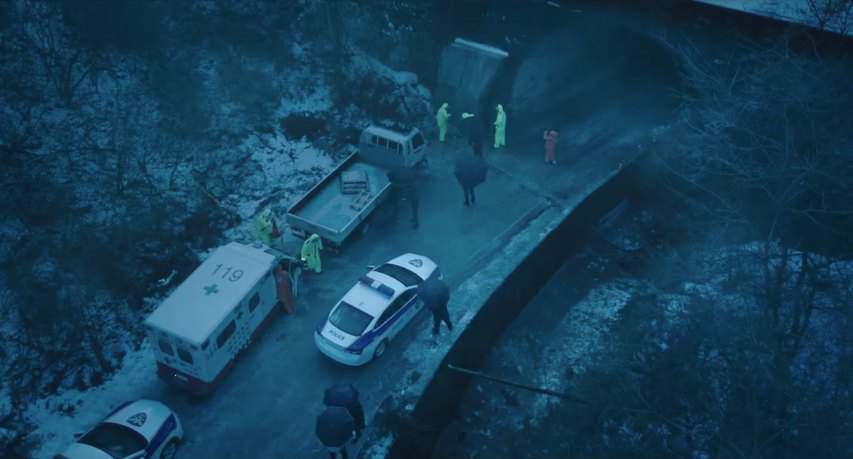Svaha: The Sixth Finger 2019

A brilliant but troubled detective investigates a series of gruesome murders that grip a city in fear. As he delves deeper, he uncovers a connection to ancient rituals and a sinister force manipulating events from the shadows. Driven by his investigative instincts, he must unravel the mystery before the killings escalate further and the truth remains hidden.
Does Svaha: The Sixth Finger have end credit scenes?
No!
Svaha: The Sixth Finger does not have end credit scenes. You can leave when the credits roll.
Meet the Full Cast and Actors of Svaha: The Sixth Finger
Explore the complete cast of Svaha: The Sixth Finger, including both lead and supporting actors. Learn who plays each character, discover their past roles and achievements, and find out what makes this ensemble cast stand out in the world of film and television.
External Links and Streaming Options
Discover where to watch Svaha: The Sixth Finger online, including streaming platforms, rental options, and official sources. Compare reviews, ratings, and in-depth movie information across sites like IMDb, TMDb, Wikipedia or Rotten Tomatoes.
Ratings and Reviews for Svaha: The Sixth Finger
See how Svaha: The Sixth Finger is rated across major platforms like IMDb, Metacritic, and TMDb. Compare audience scores and critic reviews to understand where Svaha: The Sixth Finger stands among top-rated movies in its genre.

The Movie Echo Score
Svaha: The Sixth Finger exhibits strong visual craftsmanship but struggles with narrative cohesion and character focus. Critics and viewers alike commend its accomplished cinematography and unsettling religious atmosphere, yet many note a slow build and an unsatisfying payoff that undercuts engagement. The film’s originality in blending detective procedure with supernatural themes is acknowledged, but the meandering multi-threaded plot and underdeveloped protagonist limit its emotional impact. Overall, the film leaves a mixed impression, buoyed by style and concept but hindered by storytelling shortcomings.
The Movie Echo Score Breakdown for Svaha: The Sixth Finger

Art & Craft
Visual craftsmanship is a prominent strength. Critics praise the accomplished direction and production design, while users highlight painterly lighting and composed framing reminiscent of fine art. Camera work and editing maintain a deliberate aesthetic that underscores religious themes. Even reviewers who found the narrative wanting agree that the film’s visual style offers a consistently striking and polished presentation.

Character & Emotion
Character development and emotional resonance are uneven. Multiple reviewers point out an underused protagonist whose limited agency weakens the narrative’s emotional stakes. Occasional moments of compelling drama and ending-scene emotion are recognized, but these do not fully compensate for a sense of narrative conduit. The overall impact is one of sporadic connection rather than sustained character depth.

Story & Flow
Story coherence and pacing prove challenging throughout. Critics frequently note tumbling threads and a confusing structure, while users describe meandering multi-storyline elements that dilute suspense. Occasional twists offer intrigue, but slow build-ups and an unsatisfying resolution leave many viewers disoriented. Although the concept of religious cult investigation is original, narrative unevenness undercuts sustained engagement.

Sensory Experience
Sensory and auditory elements are a highlight of the film. Reviewers commend the disconcerting score and ambient sound design that foster a pervasive sense of tension. Atmospheric visuals and sparse jump scares combine to sustain a foreboding mood, and thematic use of religious iconography enhances creepiness. While some viewers desired more overt horror moments, the understated cohesion delivers a memorable sensory experience.

Rewatch Factor
Rewatch value is limited by narrative and character gaps. Although the film’s intriguing cult-investigation premise and visual flourishes might reward repeat viewings, many viewers feel the unsatisfying payoff and unresolved plotlines diminish lasting appeal. A minority might revisit to unpack symbolic details, but overall the lack of coherence and emotional anchor curtails enthusiasm for subsequent viewings.

6.3 /10
IMDb Rating

68
%
User Score

3.1
From 12 fan ratings
Take the Ultimate Svaha: The Sixth Finger Movie Quiz
Challenge your knowledge of Svaha: The Sixth Finger with this fun and interactive movie quiz. Test yourself on key plot points, iconic characters, hidden details, and memorable moments to see how well you really know the film.
Quiz on Svaha: The Sixth Finger: Test your knowledge on the intricate details and twists of the 2019 film, Svaha: The Sixth Finger.
What is the name of Geum-hwa's hidden twin sister?
the thing
the monster
Geum-sook
the serpent
Show hint
Full Plot Summary and Ending Explained for Svaha: The Sixth Finger
Read the complete plot summary of Svaha: The Sixth Finger, including all major events, twists, and the full ending explained in detail. Explore key characters, themes, hidden meanings, and everything you need to understand the story from beginning to end.
The narrative unfolds with the tragic birth of Lee Geum-hwa and her twin sister, whose existence leads to unexpected consequences. While Geum-hwa enters the world with a deformed leg—her sister’s fetus having nourished itself parasitically—she is born into a bleak reality. Their mother tragically succumbs shortly after childbirth, and their father, overwhelmed by despair, takes his own life. As a result, Geum-hwa is raised in a remote village by her grandparents, who relocated there to raise dogs for a living. Meanwhile, her sister, deemed a “thing” by society, is concealed from public view, imprisoned in a shed in the backyard, her existence unregistered and silenced.
In the village, strange occurrences arise, prompting a group of locals, guided by a shaman, to investigate the unusual behavior of the livestock. Their search leads them to the shed, where chaos ensues as snakes escape, inflicting bites on the curious onlookers.
Amidst this, Pastor Park, a determined individual dedicated to exposing cults, embarks on an investigation into a clandestine group known as Dongbanggyo or “Deer Mountain.” Meanwhile, law enforcement opens a case regarding the discovery of a girl’s body, horrifyingly interred in concrete. During this time, Gwangmok, an individual tormented by guilt, confesses to his friend Kim Cheol-Jin, a truck driver who feels he has failed his duties to a father figure. Gwangmok reveals the haunting visits he receives from dead children at night, urging him towards oblivion.
Autopsy findings on the deceased girl unveil a talisman within her mouth, prompting the pathologist to recollect similar occurrences from the past. The police trace the girl back to Kim Cheol-Jin through his construction company, but when confronted, he tragically leapt from a rooftop. During this tumultuous period, Gwangmok is handed information about Geum-hwa by a member of Dongbanggyo, fueling his obsession to watch her closely. As nightmares of dead girls plague him, they are often accompanied by a woman singing a haunting melody.
Pastor Park delves into the origins of Dongbanggyo, discovering the scriptures penned by Kim Pungsa. His investigation leads him to the esteemed Nechung Tenpa, a Buddhist master who once sought to meet the cult’s founder, Kim Je-seok. Insights reveal that Kim Je-seok made a notable donation to a youth detention center decades prior and had adopted a group of troubled youths—one of whom was the now-deceased Kim Cheol-Jin. Through careful deduction, Park concludes that three of these boys have perished, each depicted as deities in drawings, with the surviving figure identified as Gwangmok.
As the story progresses, Gwangmok visits Geum-hwa’s home with sinister intentions, determined to bring about her demise. However, an unexpected interruption occurs when birds flock through the window, diverting his attention. Venturing to the shed, he encounters Geum-hwa’s sister, who seizes his leg and drives him away in fear.
Gwangmok subsequently arrives at the Dongbanggyo Residence, speaking to a youthful henchman. There, he learns that Geum-hwa is regarded as “the snake.” A confrontation with his fading “Father” reveals memories of being branded as Gwangmok, a protector of the light.
Park engages in a pivotal conversation with Nechung Tenpa, who recounts a significant encounter with the revered Master in 1985. Tenpa claims the Master achieved immortality, showcasing twelve fingers—an identity attributed to Donggon scriptures that foretell a “snake” set to extinguish the light. This impending malevolence is believed to emerge from the Master’s birthplace, with the prophecy linking it to the demise of young girls in the vicinity of Yeongwul during 1999.
In a chilling turn of events, Gwangmok, now having abducted Geum-hwa, contemplates her execution. As Geum-hwa queries the rationale behind her death, he chillingly labels her as evil, yet offers the unsettling notion that her death isn’t final. In a desperate plea, Geum-hwa brings up her sister, asking Gwangmok to kill her as well, dreaming of being reborn as a human in the next life.
Meanwhile, Gwangmok discovers the sister and contemplates the action he intends to take. However, she undergoes a profound transformation, adopting a serene Buddha-like form. In a shocking revelation, she confesses to having awaited his arrival, revealing her role as a comforting presence in his dark dreams. Repeating the same song as in his visions, she implores him to seek a mark from the Father figure he holds dear—six fingers, signifying a crucial prophecy.
Back at the residence, Gwangmok recants his experience to the henchman, only to learn an astonishing truth about his dying “Father,” who only possesses five fingers. This revelation culminates in a betrayal as the henchman, revealed to be Kim Je-seok himself, leads Gwangmok into a trap where he is shot. The henchman drives Gwangmok away to eliminate Geum-hwa’s sister.
While all these dark revelations unfold, Pastor Park covertly investigates the residence, confused about the origins of the old man’s illness. As he hides, it becomes clear that the ailing figure is but a disciple, with Pastor Park learning the shocking truth behind the cult’s manipulation.
Kim Je-seok eventually reveals to Gwangmok the reality of their roles in this grim narrative—he is the light while Gwangmok is but a star meant to guard him. The conversations take a deadly turn, resulting in decisions that entwine fate and morality, leading to a catastrophic car crash that enmeshes both characters in a deadly struggle amidst leaking gasoline.
In a climax filled with desperation, Gwangmok seizes an object gifted by the sister—a lighter—which he ultimately uses to set Kim Je-seok ablaze. In the poignant aftermath, Geum-hwa, still breathing, cradles her sister in her arms as she succumbs to the tragedy of their intertwined fates, marking a bittersweet end to a harrowing tale of reliance, sacrifice, and the search for redemption.
Uncover the Details: Timeline, Characters, Themes, and Beyond!

Coming soon on iOS and Android
The Plot Explained Mobile App
From blockbusters to hidden gems — dive into movie stories anytime, anywhere. Save your favorites, discover plots faster, and never miss a twist again.
Sign up to be the first to know when we launch. Your email stays private — always.
Watch Trailers, Clips & Behind-the-Scenes for Svaha: The Sixth Finger
Watch official trailers, exclusive clips, cast interviews, and behind-the-scenes footage from Svaha: The Sixth Finger. Dive deeper into the making of the film, its standout moments, and key production insights.
Cars Featured in Svaha: The Sixth Finger
Explore all cars featured in Svaha: The Sixth Finger, including their makes, models, scenes they appear in, and their significance to the plot. A must-read for car enthusiasts and movie buffs alike.
Svaha: The Sixth Finger Themes and Keywords
Discover the central themes, ideas, and keywords that define the movie’s story, tone, and message. Analyze the film’s deeper meanings, genre influences, and recurring concepts.
Svaha: The Sixth Finger Other Names and Titles
Explore the various alternative titles, translations, and other names used for Svaha: The Sixth Finger across different regions and languages. Understand how the film is marketed and recognized worldwide.
Similar Movies To Svaha: The Sixth Finger You Should Know About
Browse a curated list of movies similar in genre, tone, characters, or story structure. Discover new titles like the one you're watching, perfect for fans of related plots, vibes, or cinematic styles.
Quick Links: Summary, Cast, Ratings, More

What's After the Movie?
Not sure whether to stay after the credits? Find out!
Explore Our Movie Platform
New Movie Releases (2025)
Famous Movie Actors
Top Film Production Studios
Movie Plot Summaries & Endings
Major Movie Awards & Winners
Best Concert Films & Music Documentaries
Movie Collections and Curated Lists
© 2025 What's After the Movie. All rights reserved.














































